Bioenergy and Food Supply: A Spatial-Agent Dynamic Model of Agricultural Land Use for Jiangsu Province in China
Abstract
:1. Introduction
2. The Bioenergy Development in Jiangsu Province
2.1. The Study Area
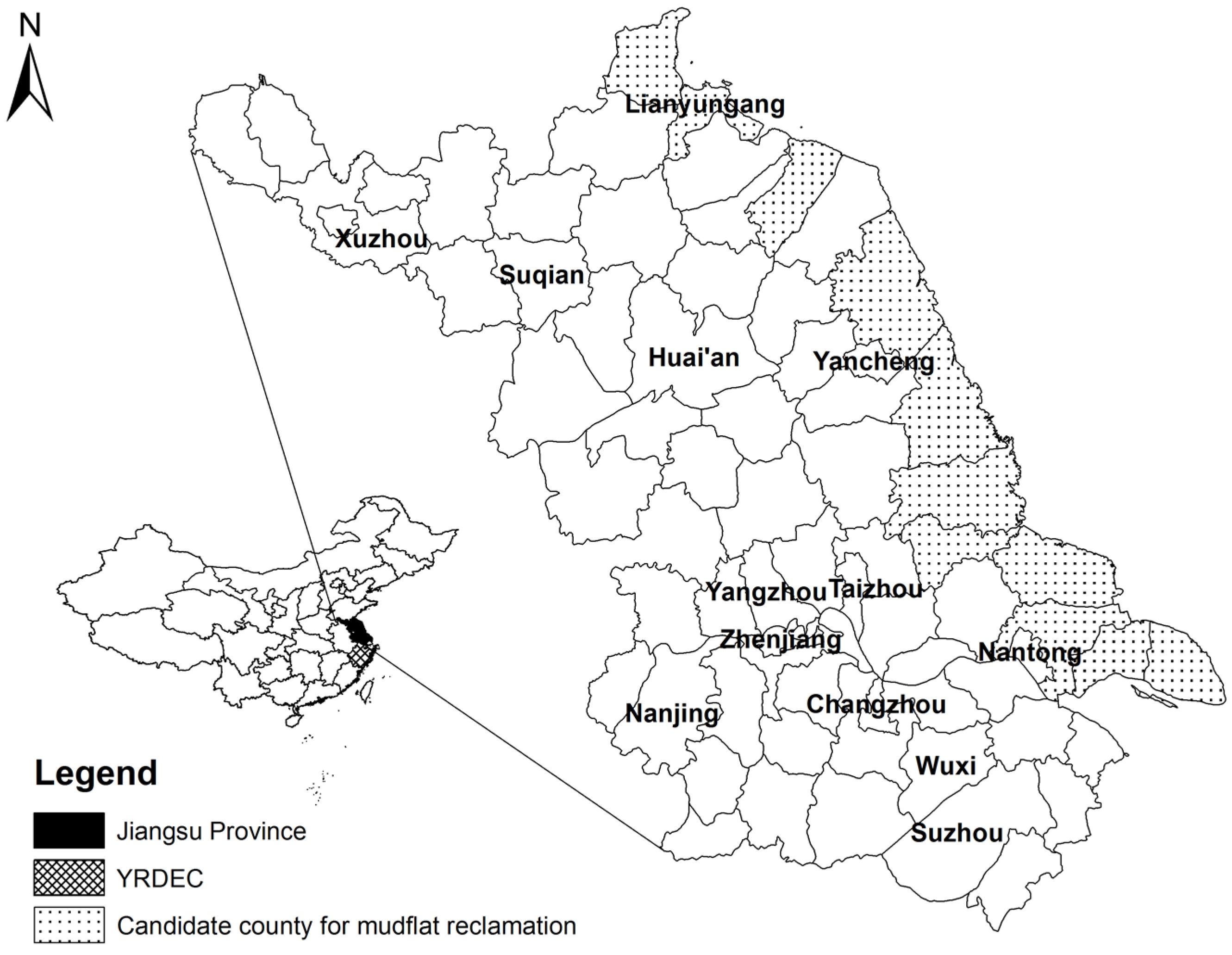
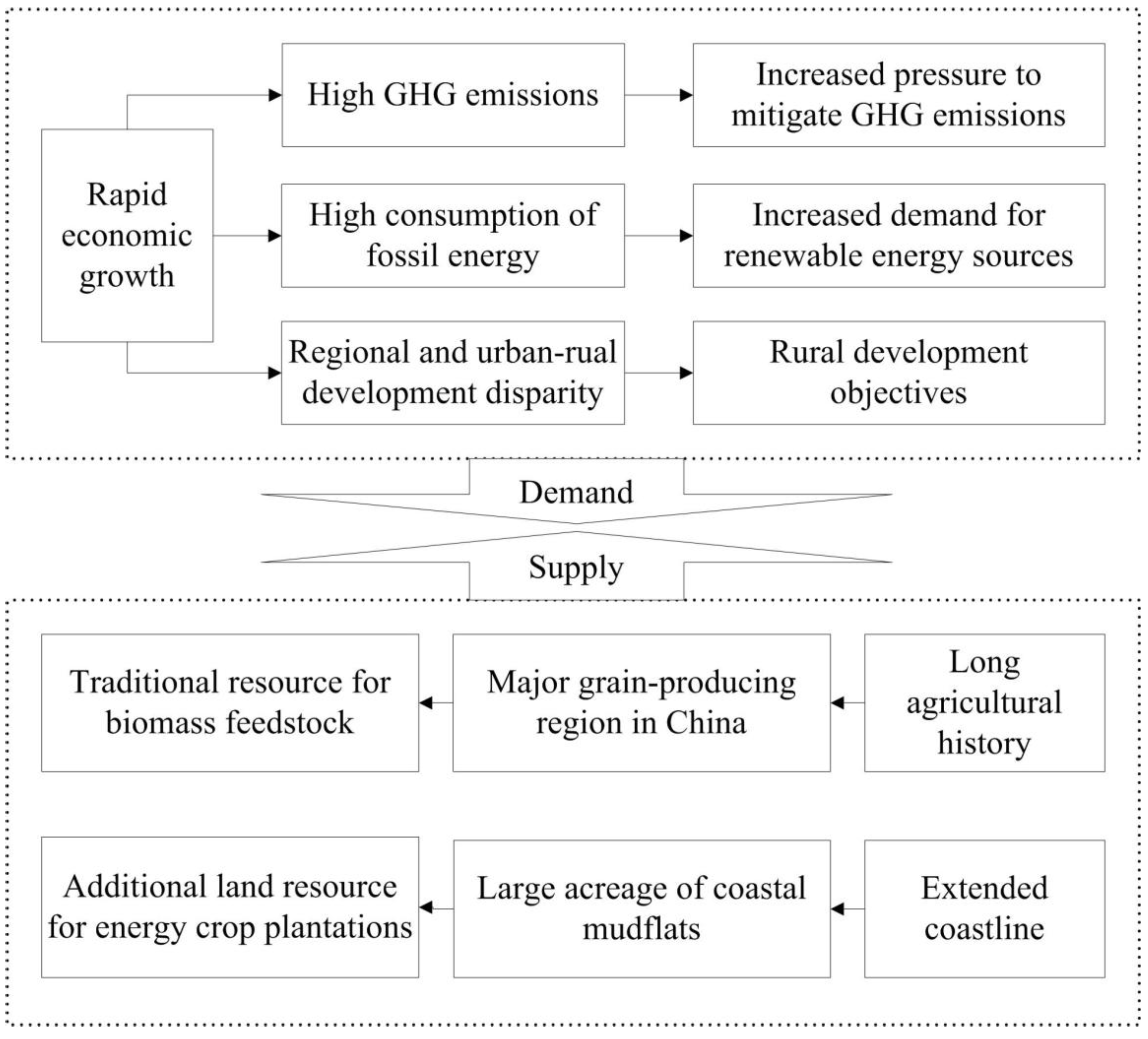
2.2. Conventional Crops
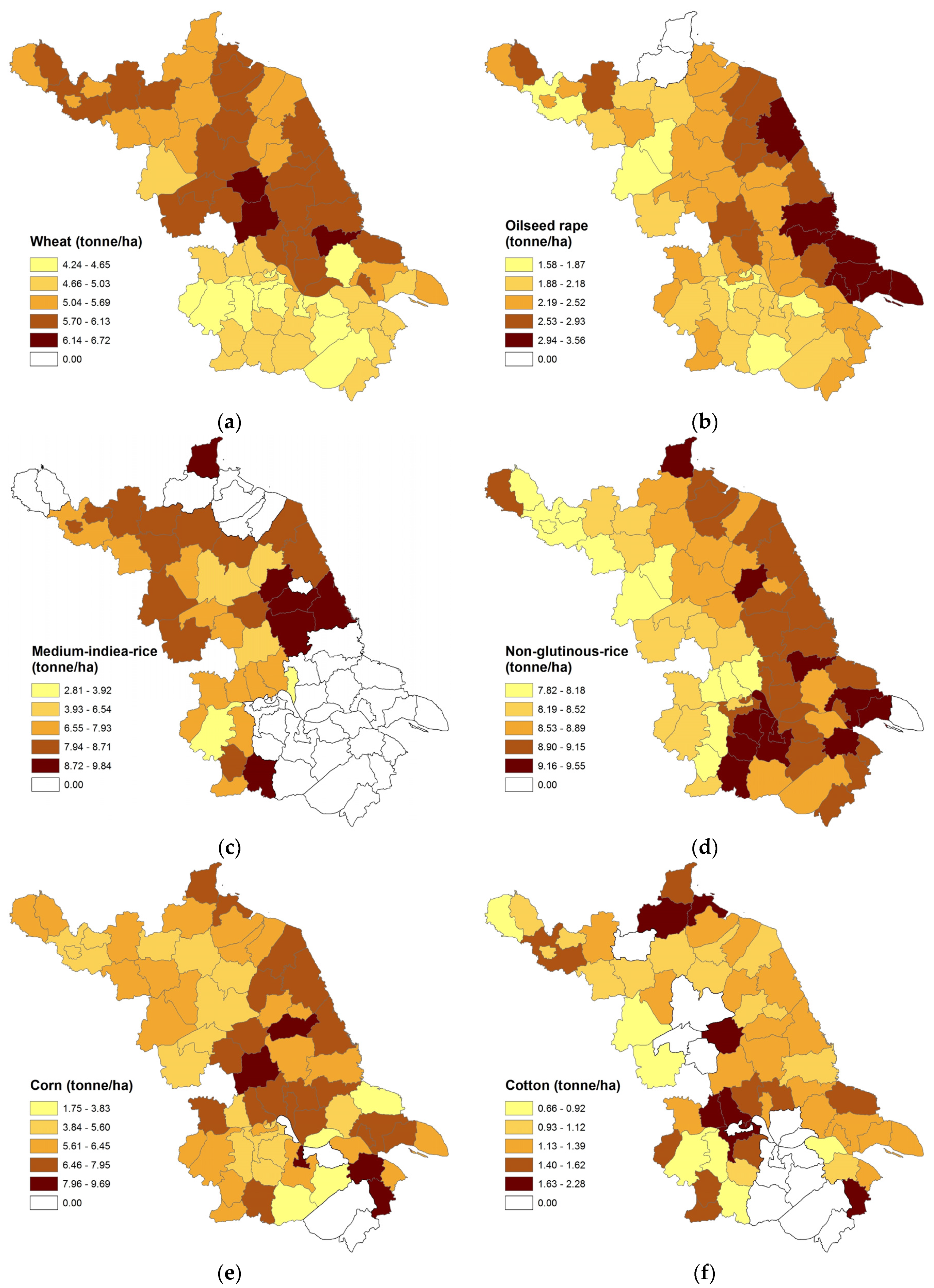
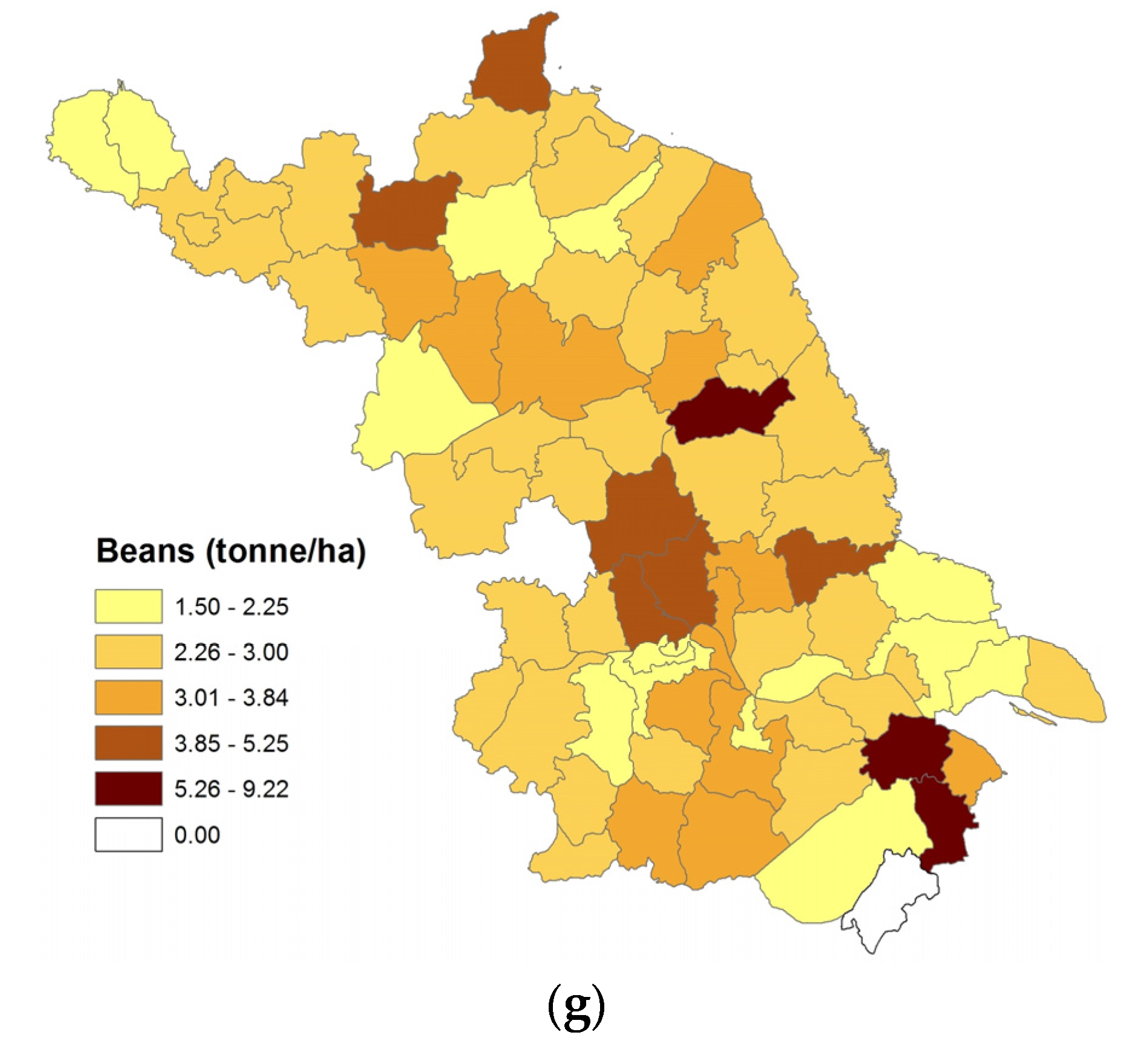
2.3. Energy Crops
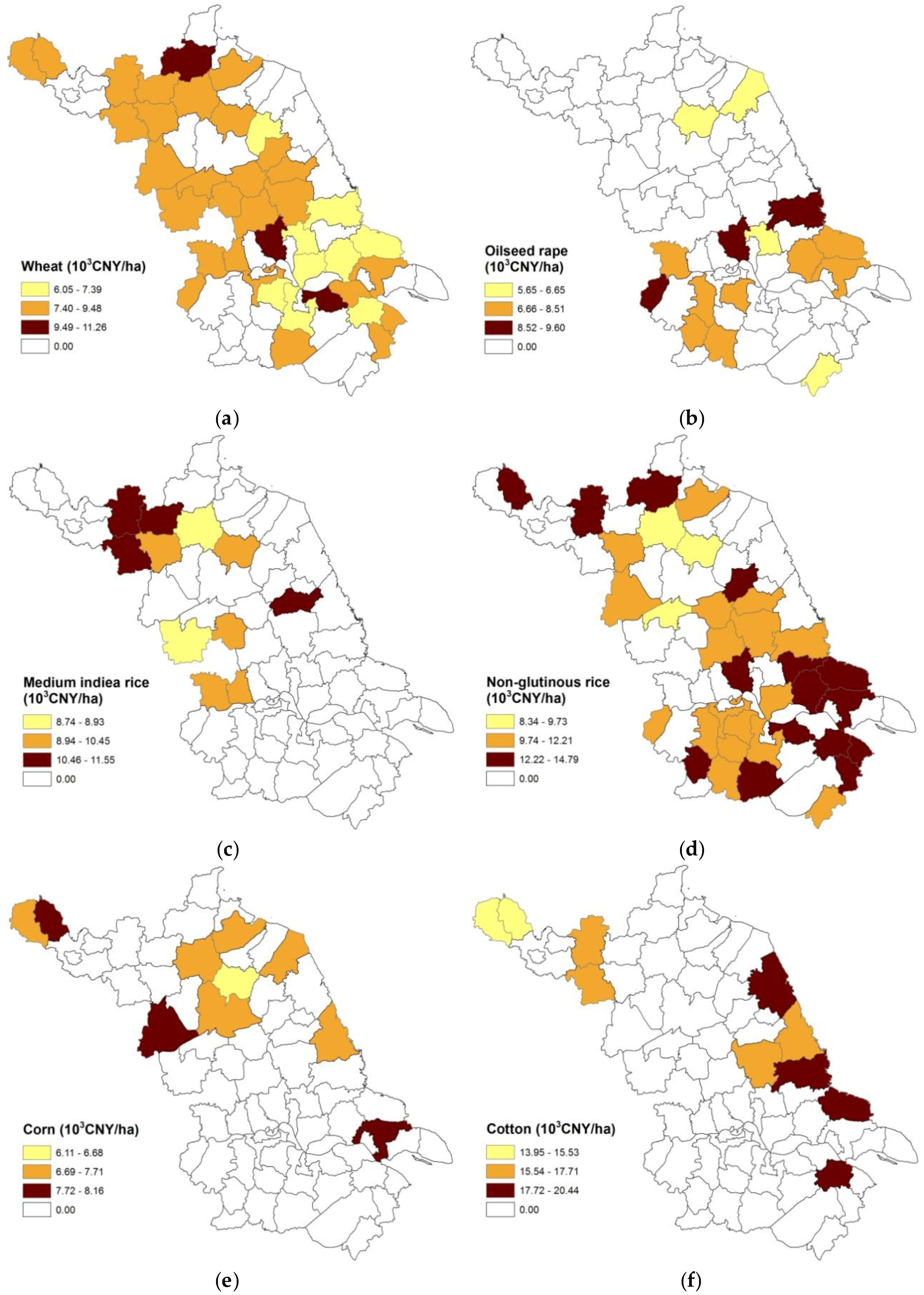
| Items | Crops | ||||||||||||
|---|---|---|---|---|---|---|---|---|---|---|---|---|---|
| Switchgrass | Silver Reed | Giant Reed | Miscanthus | ||||||||||
| Ages | |||||||||||||
| 1 | 2 | 3–10 | 1 | 2 | 3–10 | 1 | 2 | 3–10 | 1 | 2 | 3–20 | ||
| Yield (tonne/ha) | 6.8 | 15.4 | 28.1 | 7 | 17.7 | 29 | 16.2 | 30.5 | 34.4 | 9.55 | 19.4 | 30.0 | |
| Cost (per ha) | Seedling (103 CNY) | 135 | 33.8 | 0 | 90 | 0 | 0 | 90 | 0 | 0 | 423.7 | 0 | 0 |
| Planting (d) | 7.5 | 1.8 | 0 | 7.5 | 0 | 0 | 7.5 | 0 | 0 | 30.5 | 0 | 0 | |
| Maintenance (d) | 7.5 | 7.5 | 7.5 | 7.5 | 7.5 | 7.5 | 7.5 | 7.5 | 7.5 | 10.4 | 10.4 | 10.4 | |
| Harvest (d) | 15 | 15 | 15 | 15 | 15 | 15 | 15 | 15 | 15 | 44.7 | 44.7 | 44.7 | |
| Irrigation (CNY) | 600 | 0 | 0 | 600 | 0 | 0 | 600 | 0 | 0 | 600 | 0 | 0 | |
| Water (CNY) | 180 | 0 | 0 | 180 | 0 | 0 | 180 | 0 | 0 | 180 | 0 | 0 | |
| Electricity (kWh) | 846.8 | 0 | 0 | 846.8 | 0 | 0 | 846.8 | 0 | 0 | 846.8 | 0 | 0 | |
| N-Fertilizer (kg) | 150 | 150 | 150 | 150 | 150 | 150 | 150 | 150 | 150 | 165 | 69 | 103.5 | |
| Herbicide (103 kg) | 3.8 | 0 | 0 | 3.8 | 0 | 0 | 3.8 | 0 | 0 | 4.1 | 0 | 0 | |
2.4. Mudflats
2.5. Biomass and Food Demand
| No. | Bank Section (Shoal) | County | Area Suitable for Reclamation | |||
|---|---|---|---|---|---|---|
| Total | Period 1 | Period 2 | Period 3 | |||
| A01 | Xiuzhen estuary–Youwang estuary | Ganyu | 1.00 | 0.00 | 0.47 | 0.00 |
| A02 | Xingzhuang estuary–Linhongkou | Ganyu | 1.67 | 0.00 | 0.00 | 0.00 |
| A03 | Linhongkou–Xishu | Lianyungang | 2.33 | 0.00 | 0.00 | 0.00 |
| A04 | Xuwei port | Lianyungang | 4.67 | 0.00 | 0.00 | 0.00 |
| A05 | Xiaodong port–Xintan port | Xiangshui | 1.33 | 0.60 | 0.00 | 0.67 |
| A06 | Shuangyang port–Yunliang estuary | Sheyang | 1.00 | 0.00 | 0.00 | 0.93 |
| A07 | Yunliang estuary–Sheyang estuary | Sheyang | 1.67 | 0.73 | 0.00 | 0.00 |
| A08 | Simaoyou estuary– Wanggang estuary | Dafeng | 6.00 | 1.00 | 0.00 | 1.60 |
| A09 | Wanggang estuary–Chuandong port | Dafeng | 5.00 | 2.53 | 0.00 | 2.20 |
| A10-1 | Chuandong port–Dongtai estuary | Dafeng | 1.17 | 0.00 | 1.10 | 0.00 |
| A10-2 | Chuandong port–Dongtai estuary | Dongtai | 1.17 | 0.00 | 1.10 | 0.00 |
| A11 | Tiaozini | Dongtai | 26.67 | 8.00 | 9.33 | 0.00 |
| A12-1 | Fangtang estuary–Xinbeiling estuary | Dongtai | 3.33 | 1.28 | 1.87 | 0.00 |
| A12-2 | Fangtang estuary–Xinbeiling estuary | Hai’an | 2.00 | 1.92 | 0.00 | 0.00 |
| A13 | Xinbeiling estuary–Xiaoyangkou | Rudong | 4.00 | 0.00 | 3.67 | 0.00 |
| A14 | Xiaoyangkou–Juejukou | Rudong | 12.00 | 1.27 | 0.93 | 1.60 |
| A15 | Juejukou–Dongling port | Rudong | 21.33 | 2.60 | 2.60 | 8.67 |
| A16 | Yaosha–Lengjiasa | Tongzhou | 29.33 | 0.00 | 3.47 | 15.60 |
| A17-1 | Yaowang port–Haozhi port | Tongzhou | 1.92 | 0.45 | 0.40 | 0.00 |
| A17-2 | Yaowang port–Haozhi port | Haimen | 1.92 | 0.45 | 0.40 | 0.00 |
| A17-3 | Yaowang port–Haozhi port | Qidong | 3.83 | 0.90 | 0.80 | 0.00 |
| A18 | Haozhi port–Tanglu port | Qidong | 3.33 | 0.00 | 1.80 | 0.00 |
| A19 | Xiexing port–Yuantuojiao | Qidong | 3.33 | 0.00 | 1.07 | 0.00 |
| A20 | Dongsha | Dongtai | 21.33 | 0.00 | 0.00 | 13.87 |
| A21 | Gaoni | Dongtai | 18.67 | 0.00 | 0.00 | 12.13 |
| Total | 180.00 | 21.73 | 29.01 | 57.27 | ||
| Year | 2011 | 2012 | 2013 | 2014 | 2015 | 2016 | 2017 | 2018 | 2019 | 2020 |
| Biomass | 6302 | 7467 | 8632 | 9797 | 10,962 | 12,127 | 13,292 | 14,457 | 15,622 | 16,787 |
| Food | 29,720 | 29,885 | 30,050 | 30,214 | 30,379 | 30,544 | 30,708 | 30,873 | 31,038 | 31,203 |
| Year | 2021 | 2022 | 2023 | 2024 | 2025 | 2026 | 2027 | 2028 | 2029 | 2030 |
| Biomass | 17,952 | 19,117 | 20,282 | 21,447 | 22,612 | 23,777 | 24,942 | 26,107 | 27,272 | 28,437 |
| Food | 31,367 | 31,532 | 31,697 | 31,861 | 32,026 | 32,191 | 32,355 | 32,520 | 32,685 | 32,850 |
3. Model Design and Structure
3.1. Model Framework
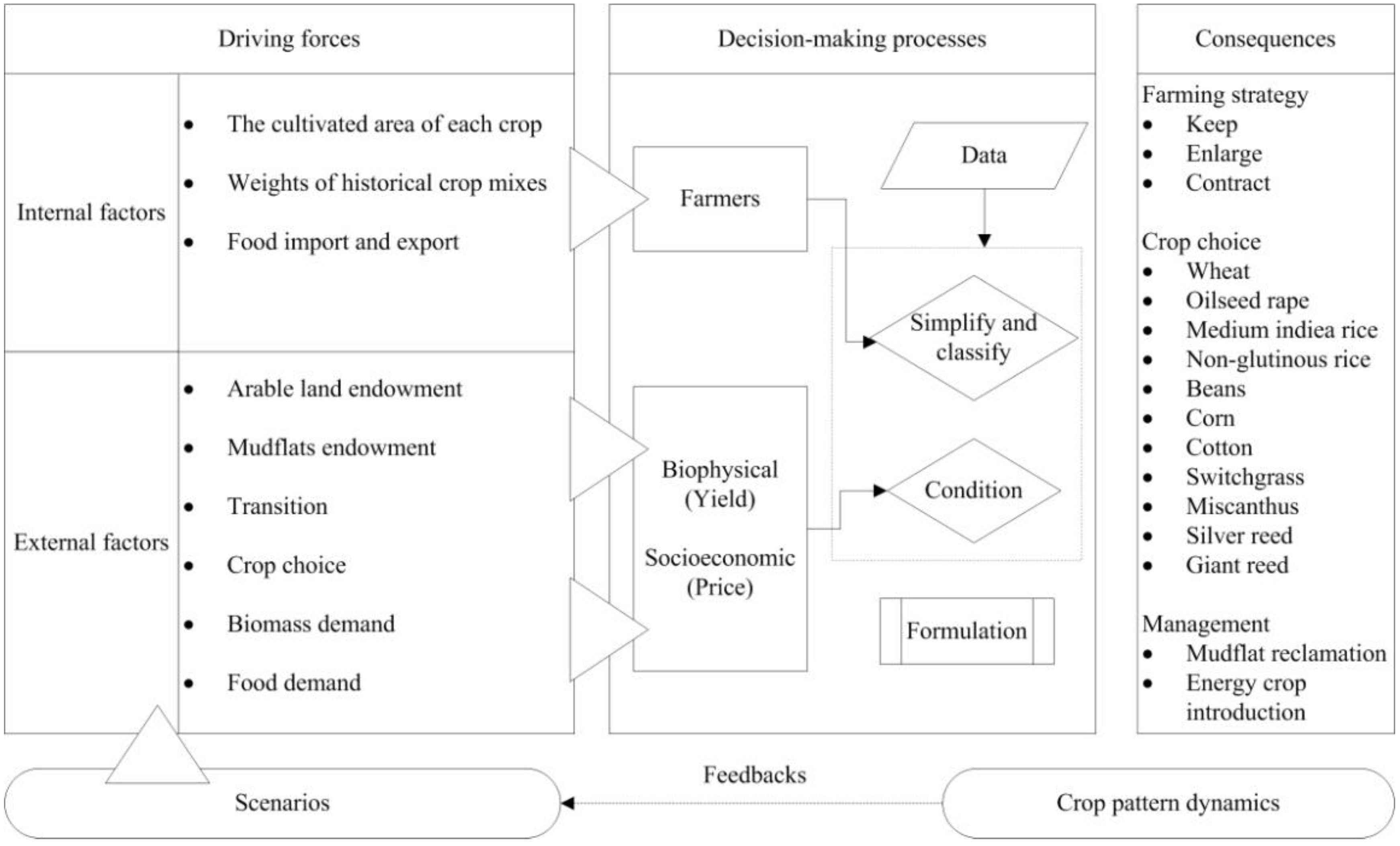
3.2. Model Structure
| Model equation | Mathematical structure | Description |
|---|---|---|
| Objective function | The sum of producer revenue in all commodity markets, minus specific and unspecific production cost and the cost of mudflat reclamation. | |
| Resource limits | The cultivated land in each region and time period cannot exceed given endowments. | |
| According to Jiangsu’s official directive, a limited area of reclaimed mudflats mainly scattered in the coastal counties can be devoted to energy crop plantation. | ||
| The area of energy crop plantation in higher age classes cannot exceed the area of the corresponding previous age class in the previous period. | ||
| Cropping activities are restricted to a linear combination of historically observed choices. Onal and McCarl [51] find that historical crop mix restrictions implicitly embody numerous farming constraints, which are difficult to observe. These include crop rotation considerations, perceived risk reactions, and a variety of natural conditions. | ||
| Biomass production needs to satisfy minimum biomass demand. | ||
| Food production needs to satisfy minimum food demand. | ||
| Decision variables | Cultivated area includes arable lands and mudflats; Crops in the model are divided into conventional crops and energy crops. | |
| The weights of historical land use patterns for decisions on land use in future years. | ||
| Inter-provincial food trade. |
4. Simulation Results
4.1. Land Use Patterns before and after the Introduction of Energy Crops
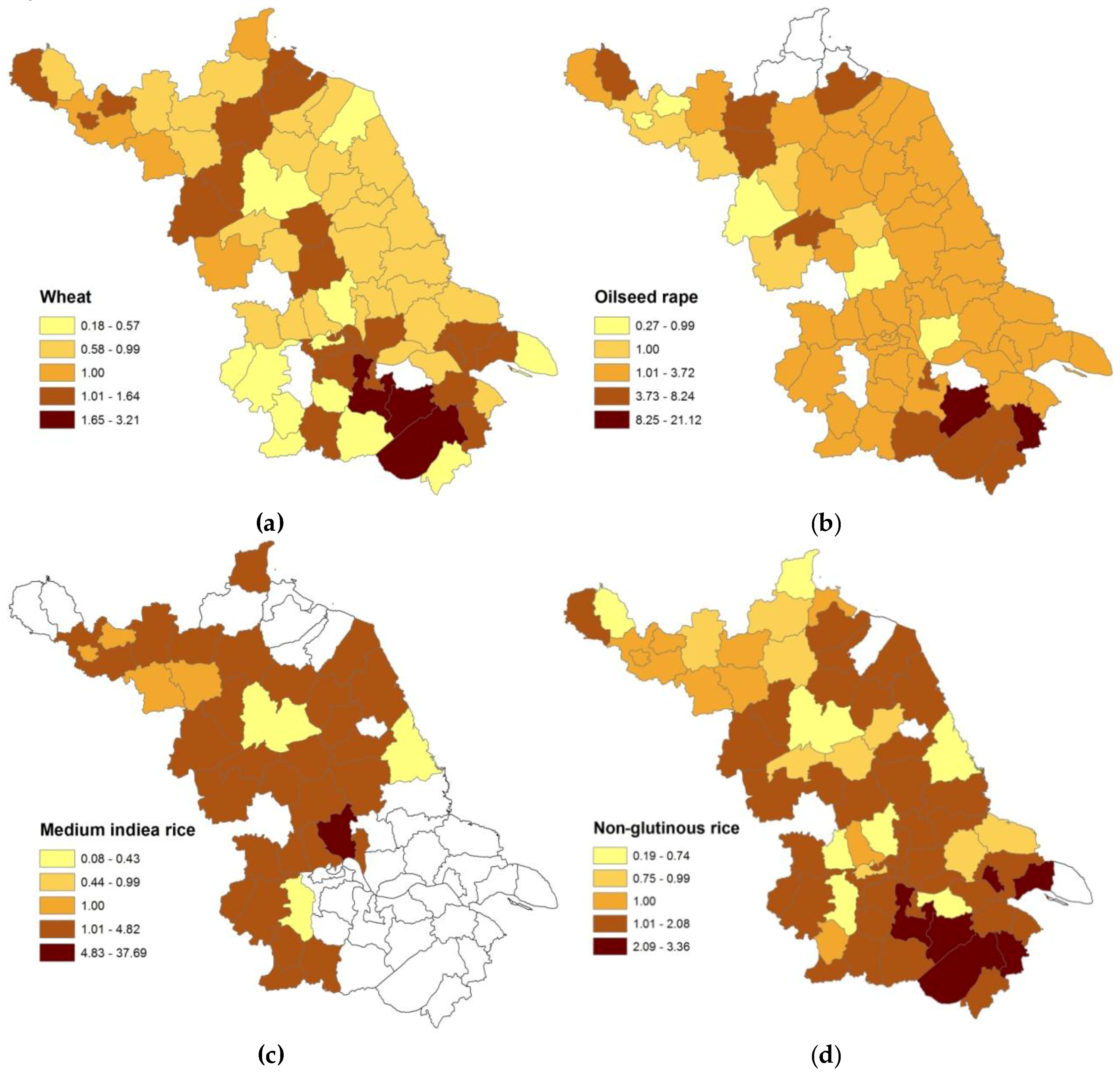
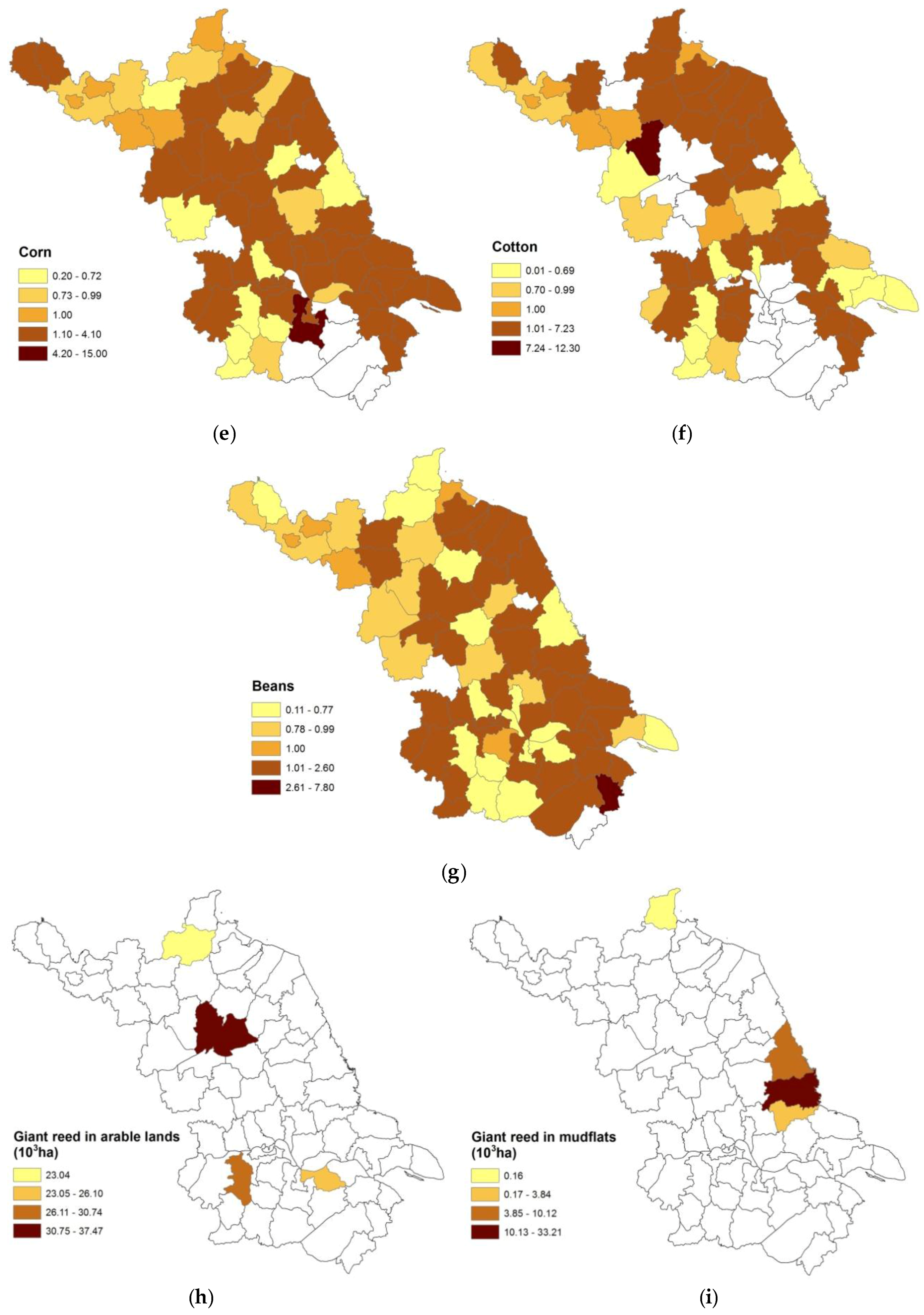
4.2. Bioenergy Feedstock Supply
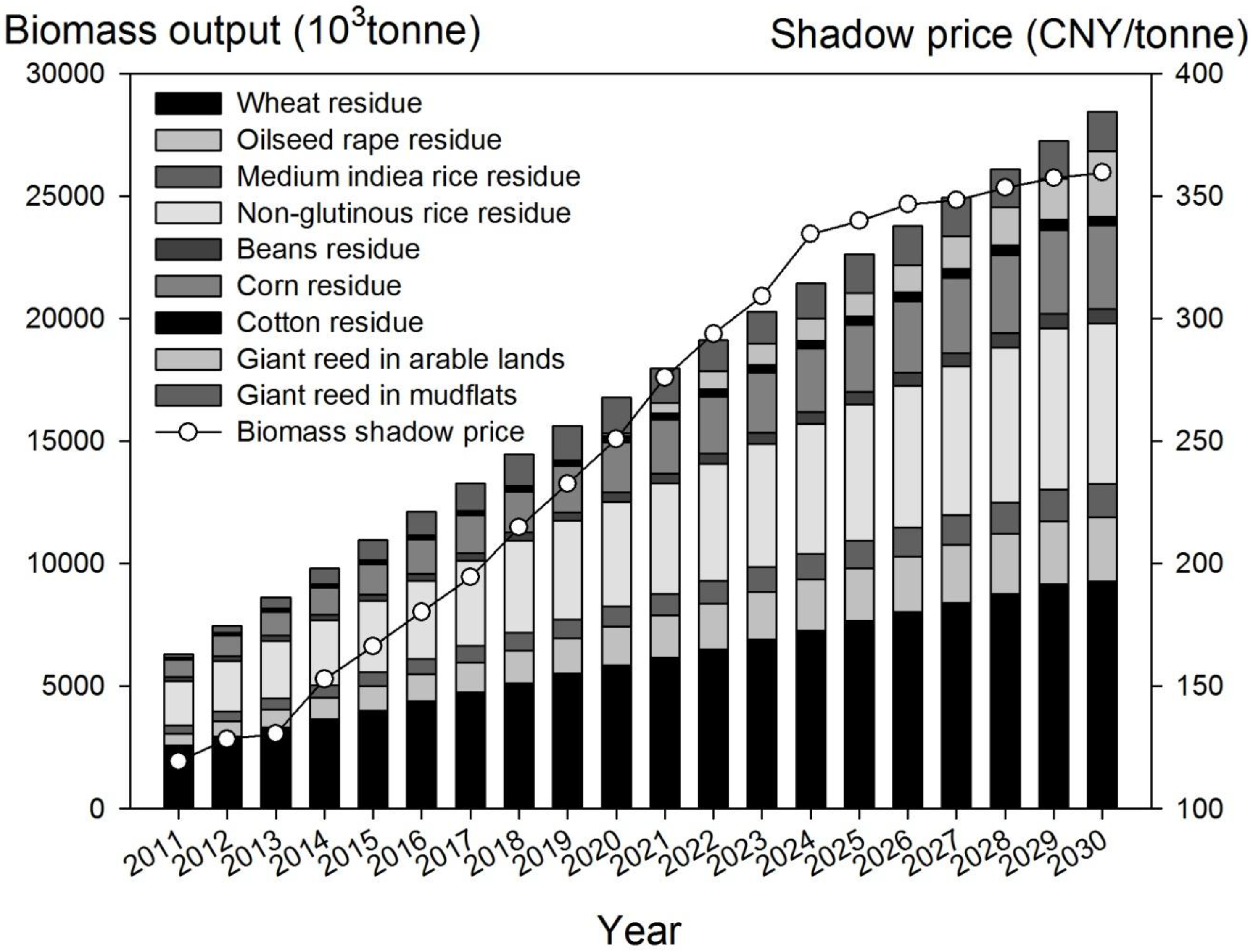
4.3. Sensitivity Analysis 1: Bioenergy Feedstock Demand
4.3.1. The Introduction of Energy Crops
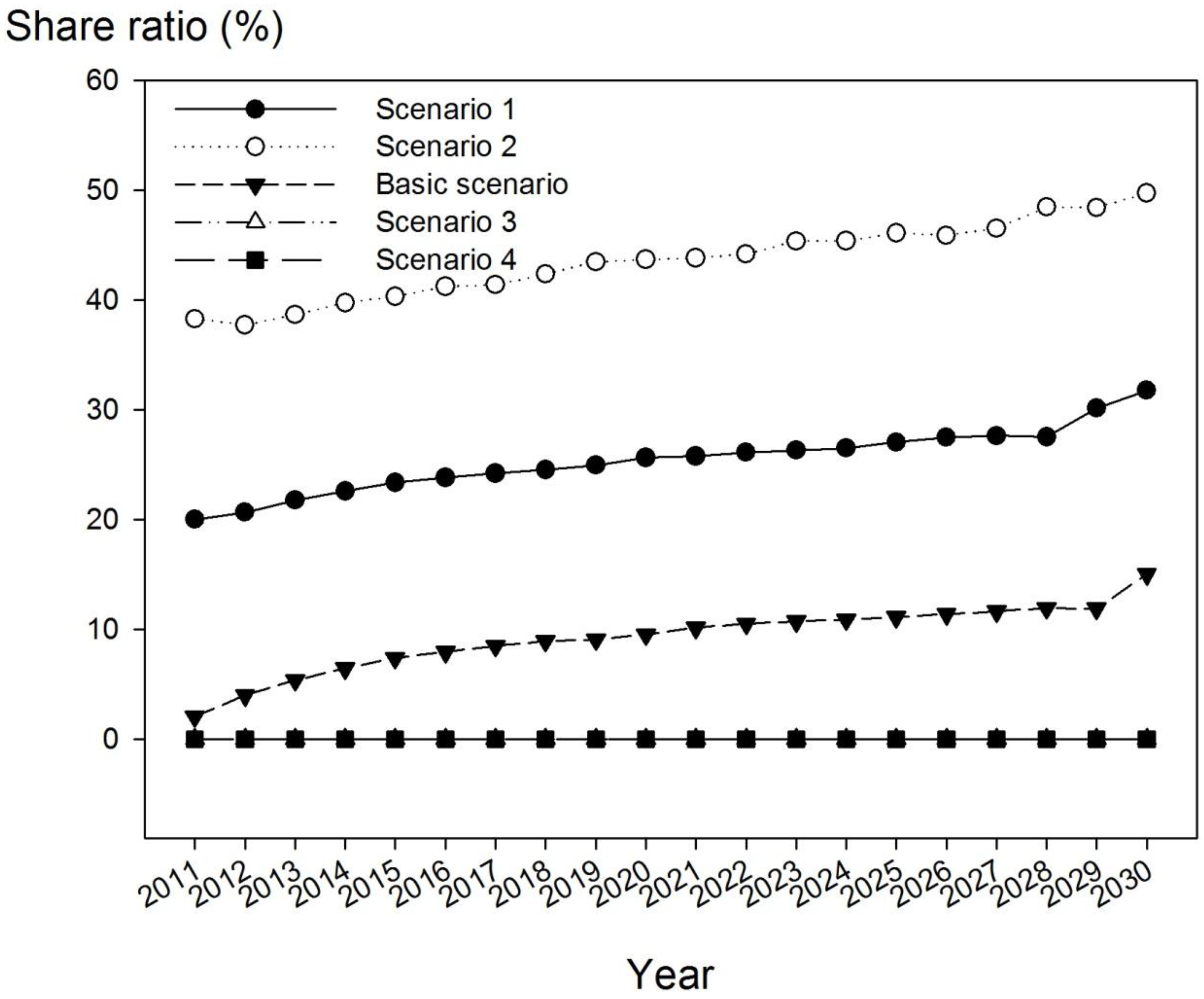
4.3.2. Differentiated Land Use Patterns in Jiangsu’s Three Sub-Regions
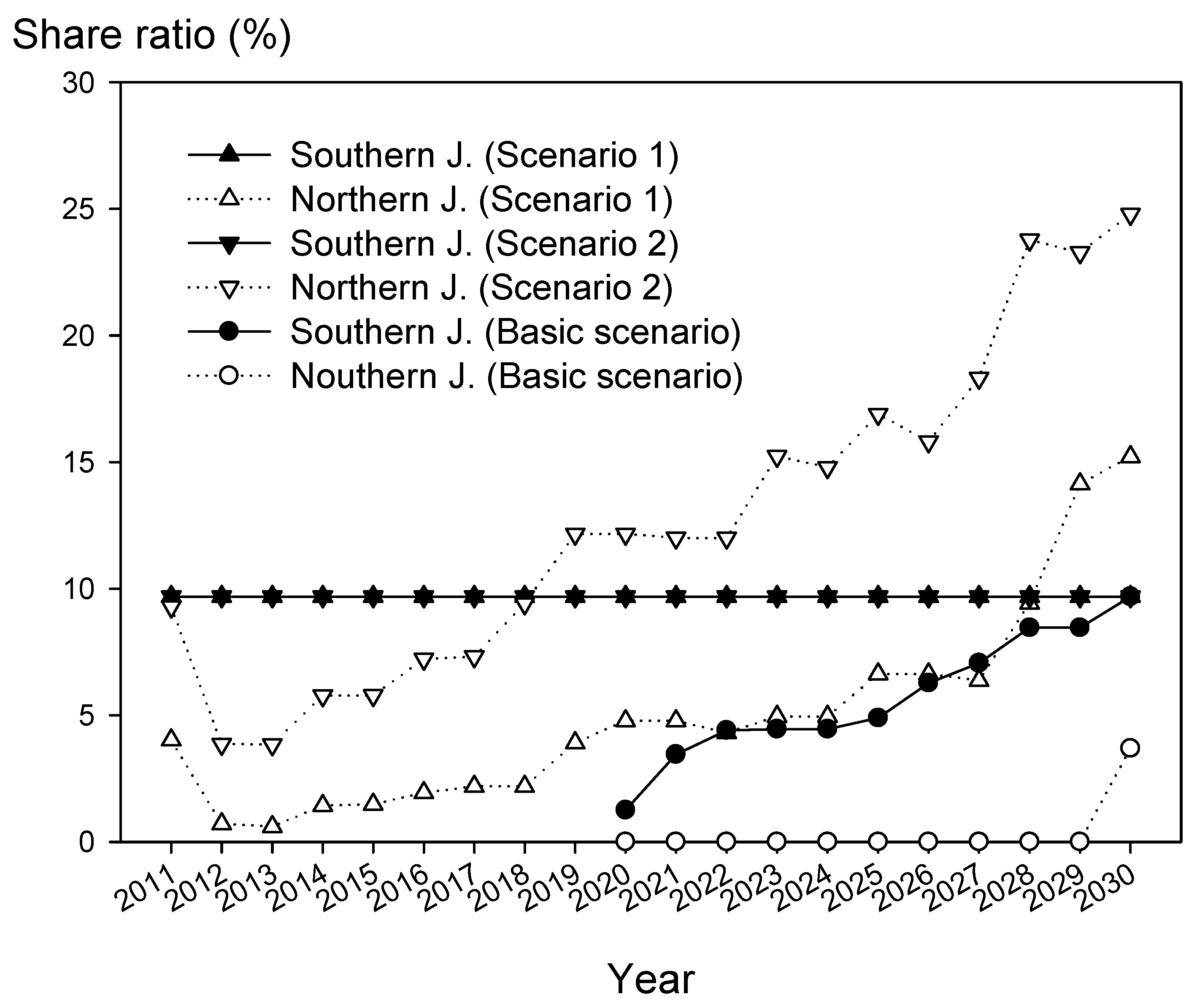
4.4. Sensitivity Analysis 2: The Role of Mudflats
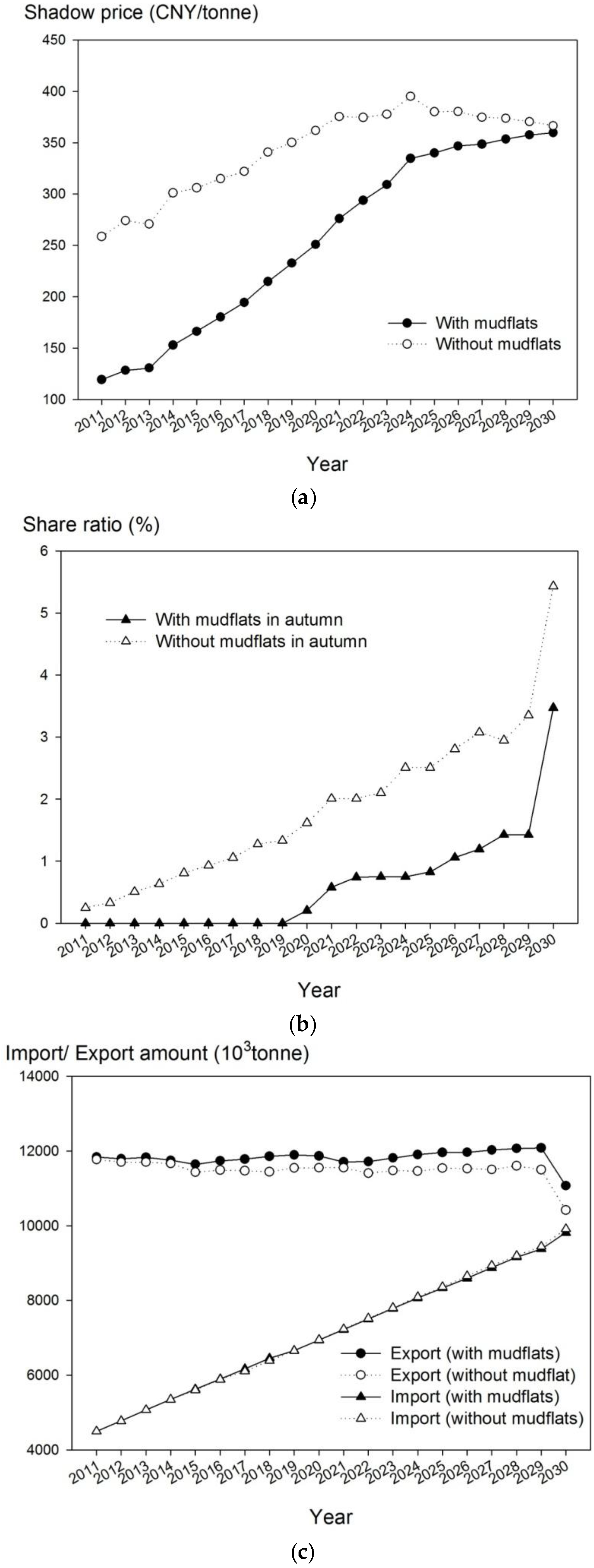
5. Discussion and Conclusions
Acknowledgments
Author Contributions
Conflicts of Interest
Appendix
The Spatial-Agent Dynamic Model Specification
Indices
| u | county-level regions (Nanjing, Pukou, Liuhe, Shushui, Gaochun, Wuxi, Jiangyin, Yixing, Xuzhou, Fengxian, Peixian, Tongshan, Suining, Xinyi, Pizhou, Changzhou, Wujin, Liyang, Jintan, Suzhou, Changshu, Zhangjiagang, Kunshan, Wujiang, Taicang, Nantong, Tongzhou, Hai-an, Rudong, Qidong, Rugao, Haimen, Lianyungang, Ganyu, Donghai, Guanyun, Guannan, Huai-an, Lianshui, Hongze, Xuyi, Jinhu, Yancheng, Yandu, Xiangshui, Binhai, Funing, Sheyang, Jianhu, Dongtai, Dafeng, Yangzhou, Baoying, Yizheng, Gaoyou, Jiangdu, Zhenjiang, Dantu, Danyang, Yangzhong, Jurong, Taizhou, Xinghua, Jingjiang, Taixing, Jiangyan, Suqian, Shuyang, Siyang, Sihong) |
| fc | food crops (wheat, oilseed-rape, medium indiea rice, non-glutinous rice, beans, corn, cotton) |
| sc | summer crops (wheat, oilseed-rape) |
| ac | autumn crops (medium indiea rice, non-glutinous rice, beans, corn, cotton) |
| pc | perennial crops (switchgrass, miscanthus, silver reed, giant reed) |
| pr | products (wheat, seeds, medium indiea rice, non-glutinous rice, beans, corn, cotton, straw) |
| pr_food | non-bioenergy products (wheat, seeds, medium indiea rice, non-glutinous rice, beans, corn, cotton) |
| pr_energy | products as bioenergy feedstock (straw) |
| t | time horizon (2006–2020) |
| s | the current policy scenario (s1) |
| n | crop season (summer, autumn) |
| a | crop age (1,2,…,20) |
| ht | historical year (2000–2010) |
| inp | the input factors during crop field management (land, family labor, hired labour, water, n-fertilizer, p-fertilizer, k-fertilizer, o-fertilizer, pesticide, agricultural-film, diesel, electricity) |
Exogenous Data
| yield of food crop (tonne/ha) | |
| yield of perennial crop (tonne/ha) | |
| price subsidy (CNY/tonne) | |
| price of non-biomass product (CNY/tonne) | |
| land subsidy for conventional crops (CNY/ha) | |
| land subsidy for perennial crops (CNY/ha) | |
| reclamation cost of mudflats (CNY/ha) | |
| total arable land area (103 ha) | |
| mudflats resource potential (103 ha) | |
| historical cultivation data (103 ha) | |
| expected lifespan of perennial crops (year) | |
| demand of bioenergy feedstock (103 tonne) | |
| demand of grains (103 tonne) | |
| r | discount rate |
| proportion of straw for energy-end use (electricity and biofuels) to its total amount (%) | |
| ratio of straw from main food crops (wheat, oilseed-rape, medium indiea rice, non-glutinous rice corn, cotton, beans) for its potential in the province (%) | |
| terminal value of perennial crop in arable land (CNY/ha) | |
| terminal value of perennial crop in mudflats (CNY/ha) | |
| terminal value of food crop (CNY/ha) | |
| consumption of input factors for cultivation of conventional crops (ha/ha, d/ha, m3/ ha, kg/ha, kWh/ha) | |
| consumption of input factors for cultivation of perennial crops (ha/ha, d/ha, m3/ha, kg/ha, kWh/ha) | |
| price of input factors for food crops (CNY/ha, CNY/d, CNY/m3, CNY/kg, CNY/kWh) | |
| price of input factors for perennial crops (CNY/ha, CNY/d, CNY/m3, CNY/kg, CNY/kWh) |
Decision Variables
| cultivated area for food crops in arable land (103 ha) | |
| cultivated area for perennial crops in arable land (103 ha) | |
| cultivated area for perennial crops in reclaimed mudflats (103 ha) | |
| weights of historical data | |
| endogenous price of biomass (CNY/tonne) | |
| import or export amount of food trade (103 t) |
Objective Function
- (1)
- The sales revenue of non-biomass from conventional crops;
- (2)
- The sales revenue of biomass from conventional crops;
- (3)
- The plantation subsidy on conventional crops;
- (4)
- The sales revenue of biomass from energy crops;
- (5)
- The plantation subsidy on energy crops;
- (6)
- The terminal value of energy crops in the terminal year;
- (7)
- The terminal value of conventional crops in the terminal year;
- (8)
- The reclamation cost of mudflats;
- (9)
- The cost of production inputs for conventional crops;
- (10)
- The cost of production inputs for energy crops.
Subject to
References
- Scheffran, J.; BenDor, T. Bioenergy and land use: A spatial-agent dynamic model of energy crop production in Illinois. Int. J. Environ. Pollut. 2009, 39, 4–27. [Google Scholar] [CrossRef]
- Hall, D.O.; House, J.I. Reducing atmospheric CO2 using biomass energy and photobiology. Energy Convers. Manag. 1993, 34, 889–896. [Google Scholar] [CrossRef]
- Jungmeier, G.; Spitzer, J. Greenhouse gas emissions of bioenergy from agriculture compared to fossil energy for heat and electricity supply. Nutr. Cycl. Agroecosyst. 2001, 60, 267–273. [Google Scholar] [CrossRef]
- Demirbas, A.H.; Demirbas, I. Importance of rural bioenergy for developing countries. Energy Convers. Manag. 2007, 48, 2386–2398. [Google Scholar] [CrossRef]
- Silveira, S. How to realize the bioenergy prospects? In Bioenergy—Realizing the Potential; Elsevier: Oxford, UK, 2005; pp. 3–17. [Google Scholar]
- Ewing, M.; Msangi, S. Biofuels production in developing countries: Assessing tradeoffs in welfare and food security. Environ. Sci. Policy 2009, 12, 520–528. [Google Scholar] [CrossRef]
- Tirado, M.C.; Cohen, M.J.; Aberman, N.; Meerman, J.; Thompson, B. Addressing the challenges of climate change and biofuel production for food and nutrition security. Food Res. Int. 2010, 43, 1729–1744. [Google Scholar] [CrossRef]
- Scheffran, J. Biofuel conflicts and human security: Toward a sustainable bioenergy life cycle and infrastructure. Swords Ploughsh. 2009, 27, 4–10. [Google Scholar]
- Ajanovic, A. Biofuels versus food production: Does biofuels production increase food prices? Energy 2011, 36, 2070–2076. [Google Scholar] [CrossRef]
- Ugarte, D.D.L.T.; He, L. Is the expansion of biofuels at odds with the food security of developing countries? Biofuels Bioprod. Biorefining 2007, 1, 92–102. [Google Scholar] [CrossRef]
- Campbell, J.E.; Lobell, D.B.; Genova, R.C.; Field, C.B. The global potential of bioenergy on abandoned agriculture lands. Environ. Sci. Technol. 2008, 42, 5791–5794. [Google Scholar] [CrossRef] [PubMed]
- Scheffran, J. Criteria for a sustainable bioenergy infrastructure and lifecycle. In Plant Biotechnology for Sustainable Production of Energy and Co-Products; Mascia, P.N., Scheffran, J., Widholm, J.M., Eds.; Springer: Heidelberg, Germany, 2010; Volume 66, pp. 409–447. [Google Scholar]
- Thomas, V.M.; Choi, D.G.; Luo, D.; Okwo, A.; Wang, J.H. Relation of biofuel to bioelectricity and agriculture: Food security, fuel security, and reducing greenhouse emissions. Chem. Eng. Res. Des. 2009, 87, 1140–1146. [Google Scholar] [CrossRef]
- Ceotto, E.; Candilo, M.D. Sustainable bioenergy production, land and nitrogen use. Sustain. Agric. Rev. 2011, 5, 101–122. [Google Scholar]
- Sadhukhan, J.; Ng, K.S.; Hernandez, E.M. Biorefineries and Chemical Processes: Design, Integration and Sustainability Analysis; John Wiley & Sons: Hoboken, NJ, USA, 2014. [Google Scholar]
- Zong, J.; Guo, A.; Chen, J.; Liu, J. A study on biomass potentials of perennial gramineous energy plants. Pratac. Sci. 2012, 29, 809–813. [Google Scholar]
- Shao, H.; Chu, L. Resource evaluation of typical energy plants and possible functional zone planning in China. Biomass Bioenergy 2008, 32, 283–288. [Google Scholar] [CrossRef]
- Zhuang, D.; Jiang, D.; Liu, L.; Huang, Y. Assessment of bioenergy potential on marginal land in China. Renew. Sustain. Energy Rev. 2011, 15, 1050–1056. [Google Scholar] [CrossRef]
- Liu, Y.; Wu, C.; Ma, X. Studies on the development and utilization of shoal land in Jiangsu province. J. China Agric. Resour. Reg. Plan. 2004, 25, 6–9. [Google Scholar]
- Zhang, D.; Zhang, F.-R.; An, P.-L. Potential economic supply of uncultivated arable land in China. Resour. Sci. 2004, 26, 46–52. [Google Scholar]
- Wang, F.; Zhu, Y. Development patterns and suitability assessment of tidal flat resources in Jiangsu province. Resour. Sci. 2009, 31, 619–628. [Google Scholar]
- Outline of Reclamation and Utilization Plan for Jiangsu Coastal Mudflat Resources (2010–2020); Development and Reform Commission of Jiangsu Province: Nanjing, China, 2010.
- Development Plan for Coastal Area of Jiangsu Province; China National Development and Reform Commission: Beijing, China, 2009.
- Development Plan for Modern Agriculture of Jiangsu Province in the 12th-five Year; Development and Reform Commission of Jiangsu Province: Nanjing, China, 2012.
- Yamamoto, H.; Fujino, J.; Yamaji, K. Evaluation of bioenergy potential with a multi-regional global-land-use-and-energy model. Biomass Bioenergy 2001, 21, 185–203. [Google Scholar] [CrossRef]
- Schneider, U.A.; McCarl, B.A. Economic potential of biomass based fuels for greenhouse gas emission mitigation. Environ. Resour. Econ. 2003, 24, 291–312. [Google Scholar] [CrossRef]
- Johansson, D.A.; Azar, C. A scenario based analysis of land competition between food and bioenergy production in the US. Clim. Change 2007, 82, 267–291. [Google Scholar] [CrossRef]
- Havlík, P.; Schneider, U.A.; Schmid, E.; Böttcher, H.; Fritz, S.; Skalský, R.; Aoki, K.; Cara, S.D.; Kindermann, G.; Kraxner, F.; et al. Global land-use implications of first and second generation biofuel targets. Energy Policy 2011, 39, 5690–5702. [Google Scholar] [CrossRef]
- Kraxner, F.; Nordström, E.-M.; Havlík, P.; Gusti, M.; Mosnier, A.; Frank, S.; Valin, H.; Fritz, S.; Fuss, S.; Kindermann, G.; et al. Global bioenergy scenarios—Future forest development, land-use implications, and trade-offs. Biomass Bioenergy 2013, 57, 86–96. [Google Scholar] [CrossRef]
- Zhang, X.; Li, S.; Huang, X.; Li, Y. Effects of carbon emissions and their spatio-temporal patterns in Jiangsu province from 1996 to 2007. Resour. Sci. 2010, 32, 768–775. [Google Scholar]
- Comprehensive Activity Plan of Energy-saving and GHG Emission Reduction of Jiangsu Province in 2011–2015; People’s Government of Jiangsu Province: Nanjing, China, 2012.
- Xu, X.; Wang, D.; Jiang, H.; Shi, H. Study on greenhouse gas emission in Jiangsu province. Water Air Soil Poll. 1999, 109, 293–301. [Google Scholar] [CrossRef]
- The 12th Five-year Energy Development Plan in the Jiangsu Province; People’s Government of Jiangsu Province: Nanjing, China, 2012.
- Comprehensive Utilization Plan for Crop Residues in Jiangsu Province (2010–2015); Executive Office of People’s Government of Jiangsu Province (EOPGJP): Nanjing, China, 2010.
- Statistic Bureau of Jiangsu Province. Statistic Yearbook of Rural Areas in Jiangsu Province (2010); China Statistics Press: Beijing, China, 2011.
- Bauen, A.; Berndes, G.; Junginger, M.; Londo, M.; Vuille, F.; Ball, R.; Bole, T.; Chudziak, C.; Faaij, A.; Mozaffarian, A.H. Bioenergy—A Sustainable and Reliable Energy Source; International Energy Agency Bioenergy: Paris, France, 2009; pp. 1–107. [Google Scholar]
- Fan, X.; Hou, X.; Zuo, H.; Wu, J.; Duan, L. Biomass yield and quality of three kinds of bioenergy grasses in beijing of China. Sci. Agric. Sin. 2010, 43, 3316–3322. [Google Scholar]
- Fan, X.; Zuo, H.; Hou, X.; Wu, J. Potential of miscanthus spp. and triarrhena spp. as herbaceous energy plants. Chin. Agric. Sci. Bull. 2010, 26, 381–387. [Google Scholar]
- Hou, X.; Fan, X.; Wu, J.; Zhang, Y.; Zuo, H. Large-scale cultivation and management technologies of cellulosic bioenergy grasses in marginal land in Beijing suburb. Crops 2011, 2011, 98–101. [Google Scholar]
- Hou, X.; Fan, X.; Wu, J.; Zuo, H. Evaluation of economic benefits and ecological values of cellulosic bioenergy grasses in Beijing suburban areas. Acta Pratac. Sin. 2011, 20, 12–17. [Google Scholar]
- Khanna, M.; Dhungana, B.; Clifton-Brown, J. Costs of producing miscanthus and switchgrass for bioenergy in illinois. Biomass Bioenergy 2008, 32, 482–493. [Google Scholar] [CrossRef]
- Zuo, H.; Yang, X.; Chen, Q. The Research Proceeding of Cellulosic Herbaceous Energy Crops. In Proceedings of the China Bioenergy Technology Route Standard System Construction Forum, Shanghai, China, 30 August 2008.
- Wang, W.; Wang, C.; Pan, Z.; Pan, Q. Using Jiangsu coastal mudflats to plant salt tolerance bioenergy crop. Jiangsu Agric. Sci. 2010, 37, 484–485. (In Chinese) [Google Scholar]
- Ling, S. Development and utilization of biomass energy in Jiangsu coastal area. Resour. Ind. 2010, 12, 117–121. [Google Scholar]
- Ling, S. Developing new energy industries of coastal area and cultivating new economic growth pole—A case study of Jiangsu coastal area. J. Yancheng Teach. Univ. 2009, 29, 20–23. (In Chinese) [Google Scholar]
- Xiong, P. The Feasibility Report on Large-scale Production of Lignocellulosic Ethanol; Unpublished internal report: Huai'an, China, 2010. (In Chinese) [Google Scholar]
- Wang, Y.; Zhao, Y.; Ding, M.; Ji, C.; Wang, C. The current status of Jiangsu’s straw resource utilization and the discussion on multiple-layer utilization pattern. Jiangsu Agric. Sci. 2010, 37, 393–396. (In Chinese) [Google Scholar]
- Li, J.; Hu, Y. Analysis on investment and operation of straw-fired power plants in Jiangsu province. Electr. Power Technol. Econ. 2009, 21, 18–22. [Google Scholar]
- Jiangsu Grain Bureau. Jiangsu grain consuming characteritics and development tendency analysis. In Grain Econ. Res.; 2005; 74, pp. 5–15. (In Chinese) [Google Scholar]
- Schneider, U.A.; McCarl, B.A. Greenhouse gas mitigation through energy crops in the US with implications for Asian pacific countries. In Global Warming and the Asian Pacific; Edward Elgar Publishing Limited: Cheltenham, UK; Northampton, MA, USA, 2003; pp. 168–184. [Google Scholar]
- Onal, H.; McCarl, B.A. Aggregation in mathematical-programming sector models and model stability. Am. J. Agric. Econ. 1991, 73, 1545–1545. [Google Scholar]
- McCarl, B.A.; Spreen, T.H. Price endogenous mathematical programming as a tool for sector analysis. Am. J. Agric. Econ. 1980, 62, 87–102. [Google Scholar] [CrossRef]
- Önal, H.; McCarl, B.A. Exact aggregation in mathematical programming sector models. Can. J. Agric. Econ. 1991, 39, 319–334. [Google Scholar] [CrossRef]
- Schneider, U.A.; McCarl, B.A.; Schmid, E. Agricultural sector analysis on greenhouse gas mitigation in US agriculture and forestry. Agric. Syst. 2007, 94, 128–140. [Google Scholar] [CrossRef]
© 2015 by the authors; licensee MDPI, Basel, Switzerland. This article is an open access article distributed under the terms and conditions of the Creative Commons by Attribution (CC-BY) license (http://creativecommons.org/licenses/by/4.0/).
Share and Cite
Shu, K.; Schneider, U.A.; Scheffran, J. Bioenergy and Food Supply: A Spatial-Agent Dynamic Model of Agricultural Land Use for Jiangsu Province in China. Energies 2015, 8, 13284-13307. https://doi.org/10.3390/en81112369
Shu K, Schneider UA, Scheffran J. Bioenergy and Food Supply: A Spatial-Agent Dynamic Model of Agricultural Land Use for Jiangsu Province in China. Energies. 2015; 8(11):13284-13307. https://doi.org/10.3390/en81112369
Chicago/Turabian StyleShu, Kesheng, Uwe A. Schneider, and Jürgen Scheffran. 2015. "Bioenergy and Food Supply: A Spatial-Agent Dynamic Model of Agricultural Land Use for Jiangsu Province in China" Energies 8, no. 11: 13284-13307. https://doi.org/10.3390/en81112369
APA StyleShu, K., Schneider, U. A., & Scheffran, J. (2015). Bioenergy and Food Supply: A Spatial-Agent Dynamic Model of Agricultural Land Use for Jiangsu Province in China. Energies, 8(11), 13284-13307. https://doi.org/10.3390/en81112369








